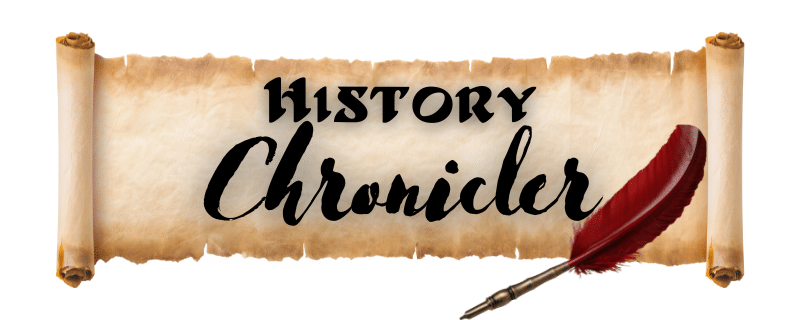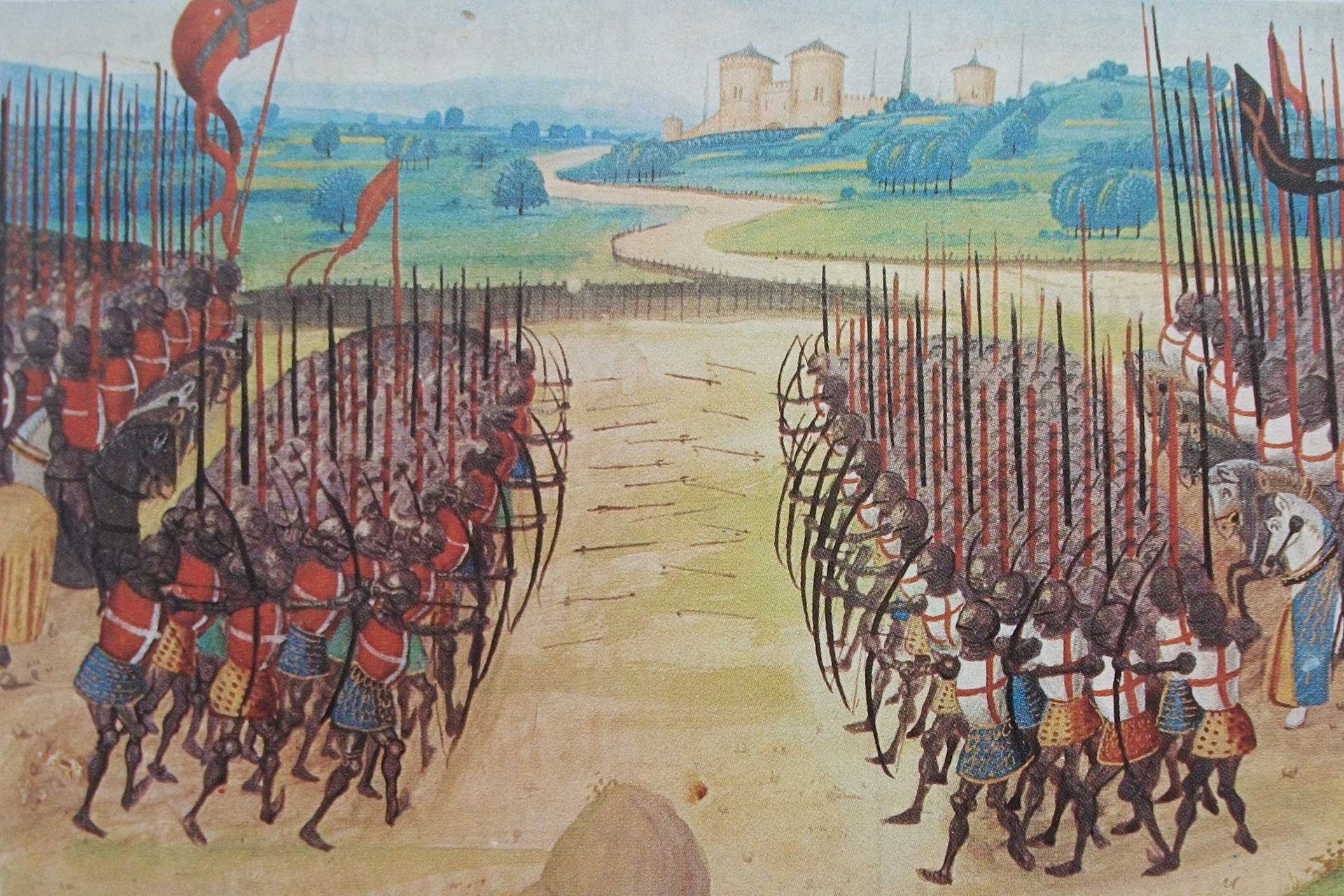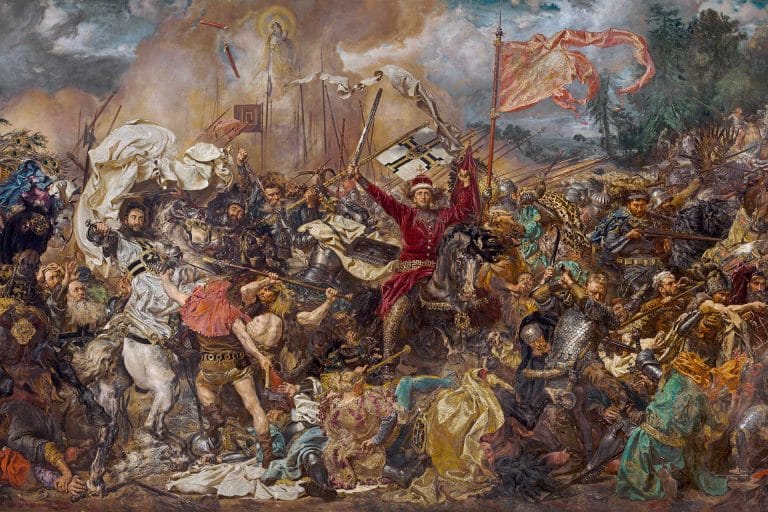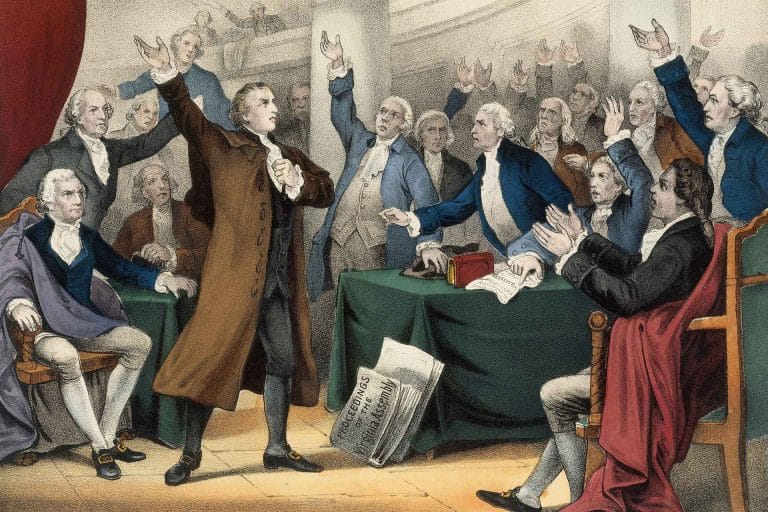9 Times the English Longbow Dominated the Battlefield
In the annals of military history, few weapons have achieved the iconic status and enduring reputation of the English Longbow. It wasn’t just a bow; it was an emblem of England’s might, a symbol of technological and tactical prowess that gave English forces a significant advantage on many a medieval battlefield. Renowned for its power, precision, and range, the English Longbow became a force to be reckoned with, striking fear into the hearts of adversaries and offering a distinctive edge in warfare strategies.
The potency of the English Longbow wasn’t simply a product of its design but also the materials used in its construction. Traditionally crafted from yew, the wood’s unique properties allowed for a bow with both tension and compression, making it possible to shoot arrows with extraordinary velocity. Compared to other contemporary bows, the longbow was superior in range and penetration.
Its imposing length, often tailored to the height of the archer, ensured that the weapon could harness significant energy and release it with devastating effect. When wielded by a skilled bowman, it could penetrate armor, breach fortifications, and turn the tide of battle. We will delve into nine engagements where the English Longbow not only played a pivotal role but demonstrated its unrivaled dominance in the theater of war. Welcome to the world of the English Longbow, a legacy of wood, string, and iron-tipped determination.
So let’s dive into these engagements in chronological order.
The Battle of Falkirk (1298): Arrows Rain and Power Shifts
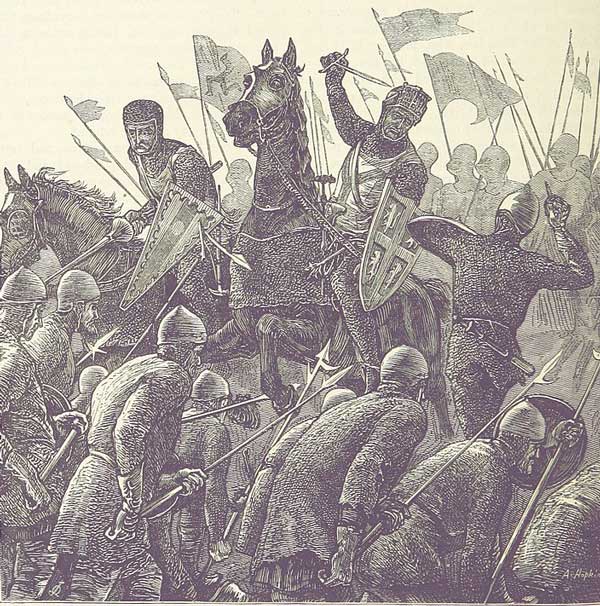
Set against the turbulent backdrop of the First War of Scottish Independence, the Battle of Falkirk, fought on 22 July 1298, stands as a testament to the might of the English Longbow. Scotland, under the leadership of the revered William Wallace, sought to resist the English claim over its territories and retain its sovereignty. England, led by King Edward I, was determined to solidify its dominance and subdue the Scottish rebellion. The ongoing struggle between these nations set the stage for a confrontation at Falkirk, a battle that would be pivotal in determining the trajectory of the war.
As both armies met on the field, the English forces had a distinct advantage, numbering around 15,000 compared to Scotland’s estimated 6,000. Crucial to this English might was a formidable contingent of longbowmen. Deployed strategically, these archers unleashed volleys of arrows, decimating the Scottish schiltron formations—circles of spearmen—that had previously proved resistant to cavalry charges. The relentless rain of arrows from the longbowmen created chaos and shattered the morale of Wallace’s forces. Despite the Scots’ bravery and the effectiveness of their schiltron formations, the overwhelming power of the English Longbow proved insurmountable.
The outcome of the battle was a resounding victory for the English. It’s estimated that Scotland suffered a heavy loss, with around 2,000 casualties, while English losses were significantly fewer. Although Falkirk did not end Scotland’s quest for independence, it undeniably showcased the strategic and lethal prowess of the English Longbow on the battlefield, solidifying its reputation as a weapon of immense power and influence in medieval warfare.
The Battle of Wodan Field (1321): A Longbow Legacy

In the tumultuous tapestry of medieval English history, the Despenser War stands out as a fierce conflict, underscoring the perils of royal favoritism and aristocratic discontent. This civil war, rooted in opposition to the unchecked power and influence of the Despensers, favorites of King Edward II, brought many battles to the English countryside. However, the Battle of Wodan Field in 1321 is particularly notable for showcasing the might of the English longbow.
The backdrop to this confrontation was a rebellion led by several English barons against the Despensers. Their expanding lands and influence at court had sparked outrage among the nobility, leading to a coalition of the disgruntled to rise against them. At Wodan Field, the conflict came to a head. The English Longbowman, already earning a formidable reputation on battlefields across Europe, played a pivotal role. These archers, wielding their renowned longbows crafted from yew, took advantageous positions, utilizing the terrain to the fullest. With their long range and rapid rate of fire, they were able to rain down arrows on the opposing forces, breaking their formations and sowing chaos in their ranks.
Despite the valiant efforts of the rebel barons, the superior tactics and the might of the longbow proved too much. The royal forces, buoyed by their longbowmen, emerged victorious. While exact casualty figures remain a matter of historical debate, it’s clear that the losses on the rebel side were significant. This battle, among others, helped solidify the English longbow’s reputation as a weapon of devastating effectiveness, shaping military tactics and strategies for years to come. In the grander scheme of things, the Battle of Wodan Field showcased how, with the right tactics and leadership, even a favored royal house could be seriously challenged by the very nobles who were meant to support it.
The Battle of Crécy (1346): The Rise of the English Longbow
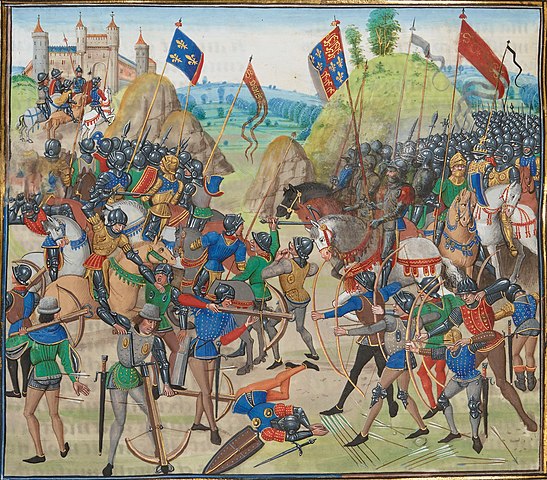
The Hundred Years’ War, spanning from 1337 to 1453, was a series of protracted conflicts waged between the crowns of England and France. A struggle for territorial control, dominance, and the assertion of legitimate claims to the French throne, the war witnessed numerous battles that left indelible marks on the annals of military history. The Battle of Crécy, fought in 1346, stands out not just as the first major confrontation in this lengthy war making our list, but also as a testament to the dominance of the English longbow – and as we’ll see, it certainly won’t be the last.
On that fateful day in August, near the town of Crécy in northern France, the English forces led by King Edward III faced a much larger French army commanded by King Philip VI. The English longbowmen, positioned on a sloping hill, became the linchpin of Edward’s strategy. These archers, armed with their formidable yew longbows, unleashed volleys of arrows with devastating precision and speed, piercing through the armor of the advancing French knights and crossbowmen. The longbow’s extended range and the archers’ ability to reload swiftly created a rain of arrows that decimated the French ranks, rendering their numerical advantage null.
The aftermath of Crécy was a clear English victory, with France suffering staggering losses, estimated to be around 4,000, including many of their nobility and knights, compared to the significantly lower casualties on the English side. King John “The Blind” of Bohemia allied to France was also killed during the fighting on the fields of Crecy.
This battle firmly established the fearsome reputation of the English longbowman and set the tone for subsequent confrontations in the Hundred Years’ War. The mastery of the longbow, as showcased at Crécy, would resonate in military circles, forever altering the dynamics of medieval warfare.
The Battle of Poitiers (1356): A Longbow Legacy Continued
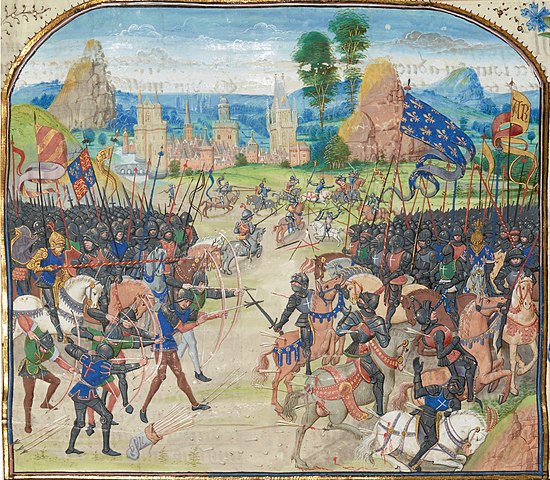
The Hundred Years’ War was marked by momentous battles, and the Battle of Poitiers in 1356 stands as another testament to the formidable might of the English longbowman. The protracted conflict between England and France was characterized by territorial ambitions, claims to the French crown, and a desire to control lucrative trade routes. Both nations sought supremacy, and their recurring military confrontations would reshape the strategies and tactics of medieval warfare.
In September 1356, near the town of Poitiers in western France, the English army, led by Edward, the Black Prince, son of King Edward III, found themselves confronted by a French force commanded by King John II. Though outnumbered, the English had a strategic advantage in their chosen position, bolstered by the presence of their seasoned longbowmen. As the French advanced, the English longbows once again unleashed their lethal prowess. With a longer range and faster reloading speed than their French counterparts wielding crossbows, the English archers rained down waves of arrows. This relentless assault threw the French lines into disarray, turning the tide decisively in favor of the English.
The Battle of Poitiers concluded with a resounding English victory. The consequences were profound for the French: King John II was captured, and their casualties were significantly high, with estimates ranging from 2,500 to 3,000, a stark contrast to the minimal losses suffered by the English. Beyond the immediate aftermath, Poitiers reaffirmed the dominance of the English longbow in the theater of war, solidifying its reputation as an instrument of unmatched strategic value.
The Battle of Shrewsbury (1403): When English Arrows Clashed
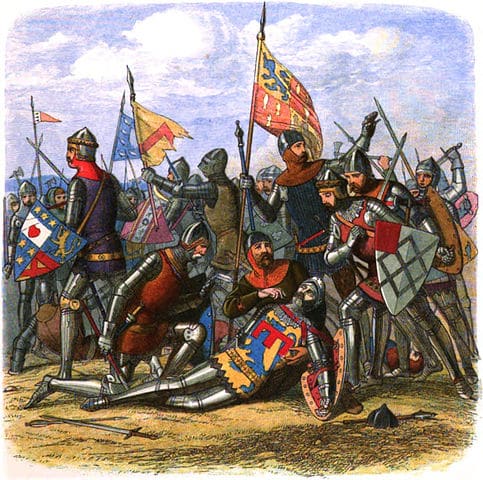
Diverging from the broader canvas of European conflict, the Battle of Shrewsbury was a distinctly English affair, pitting royal forces against rebellious factions within the realm. It was the summer of 1403 when King Henry IV’s reign faced significant internal dissent. A notable dissident, Henry Percy, better known as Hotspur due to his fiery temperament, in alliance with other malcontents, turned against the king, primarily due to perceived grievances over power distribution and the king’s handling of the Scottish borders.
On the plains near Shrewsbury, the two sides converged. While both armies were English and shared a common military heritage, the battle was marked by an unusual scenario: longbowman versus longbowman. The deadly efficiency of the English longbow was on full display, but this time it was English blood that would dampen the fields. The archers played a crucial role in determining the course of the battle. Volley after volley of arrows darkened the skies, with both sides suffering heavy casualties from this lethal rain. The intensity of the battle was such that the chroniclers noted the ground littered with arrows, making movement treacherous.
The battle reached its climax when King Henry IV’s forces managed to break the lines of Hotspur’s men, leading to the latter’s death on the battlefield. With their leader fallen, the rebels’ morale crumbled, and the royalists claimed victory. Casualties were heavy on both sides, showcasing the devastating power of longbows when used en masse. Though King Henry IV emerged triumphant, the Battle of Shrewsbury underscored the deep-rooted political and social tensions of the period, while simultaneously highlighting the transformative role of the longbow in English military strategy.
The Siege of Harfleur (1415): The Onset of a Campaign
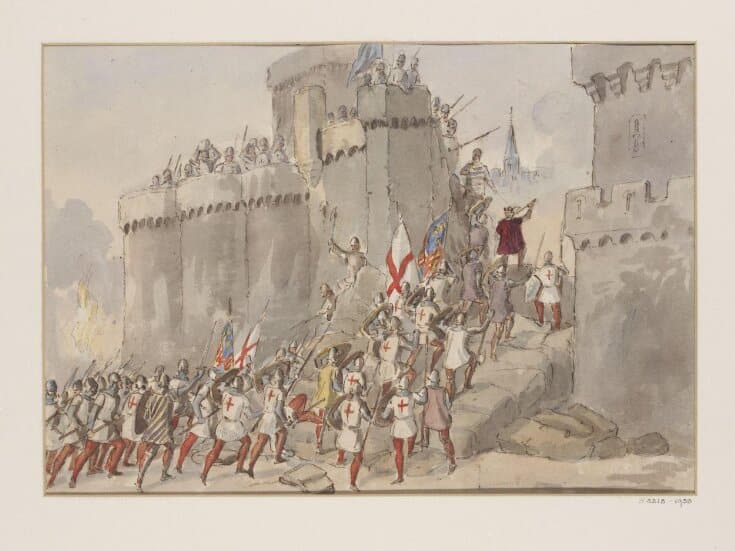
The Siege of Harfleur stands as a testament to the ambitions of a young English king keen on asserting his claims on French soil. Set against the backdrop of the Hundred Years’ War, a protracted conflict that saw the kingdoms of England and France lock horns repeatedly, Harfleur became a strategic target for King Henry V of England. Determined to enforce his claimed rights to the French throne and buoyed by a sense of religious destiny, Henry sought to capture this crucial port town as a springboard for further incursions into enemy territory.
Harfleur’s defenses, while robust, were tested to the limit by the innovative tactics of the English army. The English longbowmen, by now a feared component of the English military machine, played a pivotal role during the siege. Rather than their traditional role of raining arrows upon enemy formations from a distance, here, they were employed to suppress and demoralize the defenders, keeping them pinned and allowing the English to establish and maintain a tight stranglehold around the town. Their relentless volleys, coupled with the efforts of sappers and artillery, gradually wore down the resistance of the beleaguered French defenders.
After a grueling six-week siege, the town of Harfleur capitulated to the English. The victory, however, came at a significant cost. Disease, likely dysentery, ran rampant in the close quarters of the siege camps, leading to considerable English casualties. Henry V’s army was diminished in number, but the capture of Harfleur was a moral and strategic boost. The siege not only showcased the adaptability of the English longbowmen in varied combat scenarios but also set the stage for the subsequent and more famed Battle of Agincourt, further highlighting English military prowess during the era.
The Battle of Agincourt (1415): The Longbow’s Crowning Glory
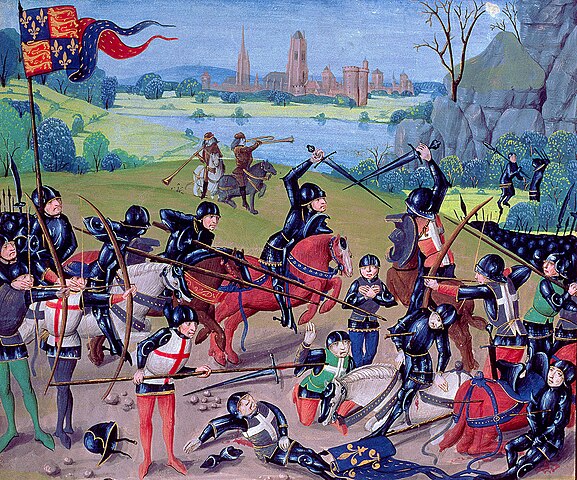
In the annals of military history, few battles resonate as profoundly as the Battle of Agincourt. Fought on October 25, 1415, this confrontation was a pivotal chapter in the prolonged Hundred Years’ War, a series of conflicts waged between the dynastic powerhouses of England and France. At its core, the clash at Agincourt was about territorial ambitions and the contested claim to the French throne by the English King Henry V. Amidst a backdrop of political intrigue, territorial disputes, and a quest for dominance, two formidable armies met on a rain-soaked field near the village of Azincourt in northern France.
The English forces, considerably outnumbered and beleaguered after the siege of Harfleur, had the Herculean task of confronting a well-equipped French army. But in their ranks, they had a weapon that would etch this battle into legend: the English longbowmen. Set in a defensive formation, these archers unleashed a torrent of arrows with such ferocity and precision that the approaching French knights and infantry found themselves ensnared in a lethal hailstorm. The muddy terrain, a result of recent rainfalls, further hampered the French cavalry, causing them to be easy targets for the longbowmen. The wooden stakes the English archers had planted before them thwarted the French cavalry’s repeated charges, turning their momentum against them.
In the aftermath of this devastating display of archery, the English emerged victorious, having inflicted severe casualties upon the French while incurring minimal losses themselves. Estimates suggest that the French suffered a staggering 6,000 to 8,000 casualties, while English losses numbered around 400. Agincourt remains the most iconic and discussed battle dominated by the English longbow, a testament to tactical brilliance, the resilience of the English forces, and the unparalleled prowess of the longbowmen. The echoes of their volleys still reverberate through history, serving as a poignant reminder of a time when the bow and arrow determined the fate of kingdoms.
The Battle of Verneuil (1424): A Sequel in Longbow Dominance

Just under a decade after the monumental victory at Agincourt, the English forces once again showcased the unparalleled might of the longbow at the Battle of Verneuil, cementing its reputation as a game-changer on the medieval battlefield. The larger conflict was an extension of the infamous Hundred Years’ War, with the English, led by the Duke of Bedford, facing a diverse coalition of French, Scots, and Milanese troops, all unified in their aim to thwart English expansion and ambitions in France.
The verdant fields of Verneuil would witness a tactical masterpiece, reminiscent of the earlier glory of Agincourt. As the opposing forces met on August 17, 1424, the English longbowmen formed the cornerstone of their battle strategy. Their lethal volleys, launched with precision and discipline, mowed down advancing enemy ranks with a ferocity that sent shockwaves through the coalition forces. The sheer rate of fire and range of the English longbows, coupled with the strategic use of defensive stakes and the tactical placement of troops, created an environment where the coalition forces were relentlessly peppered and their charges repeatedly repelled.
Victory decisively favored the English. It’s estimated that the coalition’s casualties ranged between 4,000 to 7,000, with a significant portion of the Scottish army perishing on that fateful day. In contrast, English losses were considerably lower. While Agincourt remains the most iconic representation of longbow supremacy, the Battle of Verneuil stands as a potent testament to the continued dominance of the English longbow on the battlefield, underscoring its crucial role in shaping the military outcomes of the era.
The Battle of Blore Heath (1459): An Archer’s Stand in the Wars of the Roses
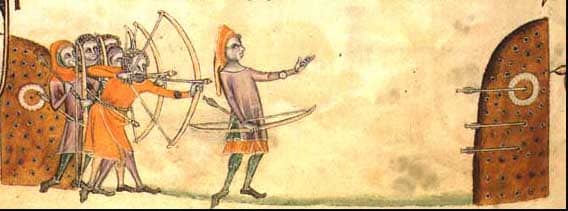
As England found itself ensnared in the intricate web of the Wars of the Roses, the country’s internal strife gave rise to numerous battles. Among these, the Battle of Blore Heath stands as a stark testament to the prowess of the English longbow. Pitting the Houses of Lancaster and York against each other, the battle was a product of the bitter feud for the English throne. The Lancastrians, loyal to King Henry VI, sought to suppress the Yorkist forces, who rallied behind Richard, Duke of York and his key supporter, Richard Neville, Earl of Salisbury.
On the day of the battle, September 23, 1459, the Earl of Salisbury’s Yorkist army was significantly outnumbered by the Lancastrian forces led by Lord Audley. As Salisbury marched towards Ludlow, he was intercepted by Audley at Blore Heath. Here, the English longbowmen, integral to the Yorkist strategy, took center stage. With Salisbury’s troops positioned defensively behind a makeshift barrier of wagons, the longbowmen unleashed volleys of arrows, halting the multiple Lancastrian charges. The terrain, coupled with the devastating efficiency of the longbow, turned the tide in favor of the outnumbered Yorkists.
In the aftermath, the Lancastrians suffered heavy casualties, with estimates ranging up to 2,000 men, including Lord Audley himself. The Yorkists, on the other hand, faced significantly fewer losses and emerged victorious. While the Wars of the Roses witnessed numerous battles, Blore Heath is renowned not just for the victory of an outnumbered force, but for the instrumental role played by the English longbowmen. Their unyielding stance and unparalleled skills, even amidst the chaos of civil war, further solidified the weapon’s legendary status in English military history.
From Bows to Bullets: The Decline of an Empire’s Weapon
The annals of military history are rarely without tales of weapons that shaped empires, and in the case of England, the longbow holds a paramount place. These engagements are but a glimpse into the numerous battles where English longbowmen not only defended their homeland but also expanded its frontiers. Through rain, mud, and against seemingly insurmountable odds, these archers carved out victories that helped England lay the foundation stones of an empire upon which, it was once said, the sun never set.
Yet, as with all things, the tides of time and technology wait for none. The advent of gunpowder and the cannon ushered in a new era of warfare, one in which the longbow, for all its precision and power, began to lose its sheen. These new instruments of war offered greater range and destructive capability, relegating the once-dominant longbow to a lesser role on the battlefield. The symphony of bowstrings and the whistle of arrows soon gave way to the roar of cannons and the crack of musket fire.
In retrospect, while the English longbow and its wielders may have bowed to the relentless march of progress, their legacy remains undiminished. They stand as a testament to the innovation and indomitable spirit of an age and a people, reminding us of a time when wood, string, and arrow shaped the destiny of a nation and an empire.
